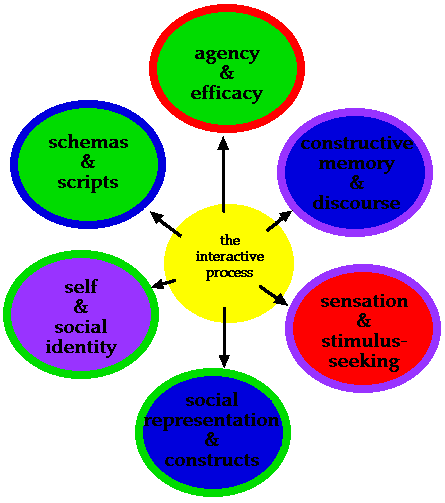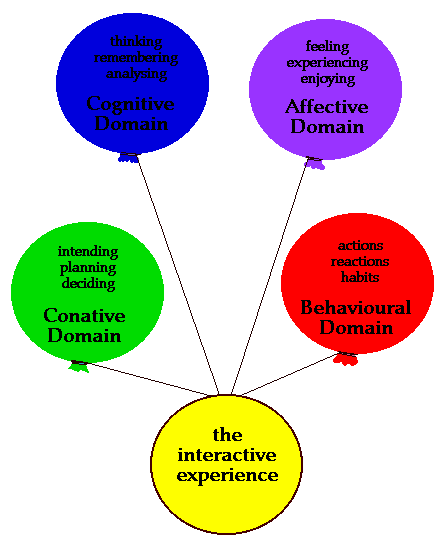

The essence of the paper is a model of the psychology of interactive exhibits, which can be portrayed as follows:

What it is saying is that when we are considering how interactive exhibits impact with visitors, we need to look at how aspects of the design of the exhibits - the design constructs - interact with underlying psychological processes, to produce particular outcomes.
We have been developing this model as an iterative process, which is to say that there has been a constant process of dialogue between myself, developing the theory, and people applying it in various fields; most notably Peter Trevitt, at the Science Museum in London. It is constantly being refined as our experience in applying it develops. This is the current version. Watch this space.
The design features which we have identified as particularly significant in interactive exhibits are as follows:

These design features trigger off a number of psychological processes. The main psychological processes which we have actually been looking at can be summarised as follows:

Some of these psychological processes, in their turn, feed back to the design process, and leading to aspects of the design being adjusted. The most obvious of these is social identification, and I will be looking specifically at how this has its impact in future research.
The psychological processes, in their turn, are what produce the distinctive outcomes of an interactive exhibit. So one important implication of the model is that what appears to be a straightforward relationship between the design of an exhibit and its outcomes actually takes a more complex route, via a number of psychological processes in the visitor.
The outcomes, too, are not all cognitive. Some of them are, and there has been considerable research in how to evaluate and measure there. Other outcomes, however, operate in different psychological domains.
Most people are familiar with the tripartite division of psychological domains into cognitive, affective and behavioural. But these actually have a more complex history. What we now refer to as the behavioural domain is a relatively recent innovation, introduced by behaviourist psychology in the first half of the twentieth century to supplant the original conative domain described by the ancient Greeks. The conative domain concerns will, intentionality and planning; but the behaviourist model of human psychology argued that these were illusion: that what aappeared to be intentionality was simply the outcome of various behavioural contingencies. They supplemented it with the behavioural domain, which was concerned with how people act - with what they actually do.
Nowadays, we are prepared to recognise that people do have intentions and that these may not be purely illusion. So we are able to reintroduce the conative domain. At the same time, we also recognise that there is value in looking at the behavioural domain, since intentions and actions do not necessarily always coincide. So we end up with four domains: cognitive, affective, conative and behavioural.

This four-domain model of the outcomes of interactive exhibits is proving useful to many people for evaluating the impact of exhibitions. It has also been used to structure design proposals when developing exhibits. We need to conduct more research into appropriate methods of measuring the four domains, and some of this is already taking place. So far, however, the model has proved useful in several different aspects of interactive design.
You are welcome to use any or all of this material as long as credit is given to its source.
